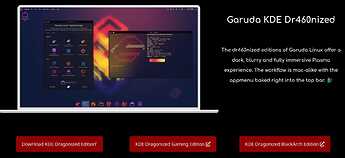Hey.
I was installing KDE Dr460 today, a fresh ISO, and I've been getting this error. It's a live boot.
Installation Failed
Bootloader installation error
The bootloader could not be installed. The installation command
grub-install --target-i386-pc --recheck --force /dev/sda
returned error code 1.
This also happened with an ISO that I have from March. Anyone know how I can fix this?
Hey! Can you check if the system has been installed through the livecd if yes try to manually install grub on the EFI partition or simply run the garuda-boot-repair application included with the live USB.
1 Like
dalto
29 July 2021 11:41
3
Are you trying to do a UEFI install or a Legacy/BIOS install?
Did you use manual partitioning?
4 Likes
No, it's 64 bit. And I'll try those, thanks
Ah, I'm not sure what the answer to your first question is, but yes, I am using manual partioning. I dual boot Linux and Win10. I used to have EndeavourOS for a while before I decided to switch back to Garuda, could that have had anything to do with it?
dalto
29 July 2021 12:33
6
The grub install that is failing above is for a legacy install so I wanted to make sure that is what you wanted. If your Windows install is legacy than should install legacy, if it is UEFI, you should install UEFI.
If you don't know, you could boot off the installation ISO and share with use the output of sudo parted -l. That would probably give us a good idea.
3 Likes
So I checked, and unfortunately, garuda-boot-repair just gives this:
`Could not set up chroot environment.
Please double check the location.`
I'm pretty sure Garuda is on sda7/, and installation shows sda7/ as Garuda Linux, so I think it has been installed after all.
If its 64 bit the installer is installing 32 bit grub whoch won't work so chroot into your system and manually install grub.
sudo parted -l gives out:
Model: ATA ST2000LM007-1R81 (scsi)
Disk /dev/sda: 2000GB
Sector size (logical/physical): 512B/4096B
Partition Table: gpt
Disk Flags:
Number Start End Size File system Name Flags
1 1049kB 274MB 273MB fat32 EFI system partition boot, esp
2 274MB 290MB 16.8MB Microsoft reserved partition msftres
3 290MB 149GB 149GB ntfs Basic data partition msftdata
7 149GB 216GB 66.5GB btrfs root boot, esp
4 216GB 1973GB 1757GB ntfs Basic data partition msftdata
5 1973GB 1999GB 26.8GB ntfs Basic data partition msftdata
6 1999GB 2000GB 1049MB ntfs Basic data partition hidden, diag
Model: SanDisk Cruzer Blade (scsi)
Disk /dev/sdb: 15.7GB
Sector size (logical/physical): 512B/512B
Partition Table: msdos
Disk Flags:
Number Start End Size Type File system Flags
2 2470MB 2474MB 4194kB primary esp
Model: Unknown (unknown)
Disk /dev/zram0: 3889MB
Sector size (logical/physical): 4096B/4096B
Partition Table: loop
Disk Flags:
Number Start End Size File system Flags
1 0.00B 3889MB 3889MB linux-swap(v1)
As I said please chroot into your system and install grub
From Grub fails after update - #3 by librewish
Some unlucky times that your system is not bootable and the only advised option is to use chroot from a Live ISO to repair the installed system (for example, to (re)install the bootloader), here is the suggested method:
steps required to chroot to your installed Garuda installation (btrfs)
Boot to a Garuda usb Live ISO
Start a terminal and
Find your installed system (btrfs) partition, you need the /dev/<something> part.
lsblk -f
Warning: Remem…
Alright, I'll try that, thanks.
dalto
29 July 2021 13:18
12
Given this is a clean install, I think this is not the right approach. Since the install broke in the middle, are you sure it is complete? You might be getting a system up and running that isn’t right or supportable.
It looks to me like you just booted the ISO in legacy mode instead of UEFI and/or made a mistake in manual partitioning.
I would reboot and make sure you boot in UEFI mode. When you the select the device to boot from there may see the removable device listed twice(or more). Choose one of the efi/uefi options. Then reinstall.
3 Likes
SGS
29 July 2021 13:19
13
BTW, we do not offer KDE D460,
I know no one has read the template that appears when you want to open a topic, so I’m posting here again.
Read
Writing a well formatted post in the forum (Discource powered) is important, if you want readers to easily read and understand.
It’s especially important for terminal output.
Here is a brief tutorial.
please
inxi -Fza
as text!
Even if you personally think it is unnecessary.
and
6 Likes
Actually the system is copied over at starting till about 30% in calmares. At around 30%, the copying of the files is completed (which will take the longest), then the installer will create the users, remove Live system specific packages, install additional packages, remove any language packs & drivers not needed for your specific hardware, setup either GRUB for BIOS systems or Systemd-boot as bootloader. So you should be able to chroot in
Sorry, I wasn't near my laptop when I wrote the post so I forgot about it. Here's the output.
System: Kernel: 5.13.5-zen1-1-zen x86_64 bits: 64 compiler: gcc v: 11.1.0
parameters: BOOT_IMAGE=/boot/vmlinuz-x86_64 lang=en_US keytable=us tz=UTC misobasedir=garuda
misolabel=GARUDA_DR460NIZED_SOARING_ quiet systemd.show_status=1 driver=nonfree
nouveau.modeset=0 i915.modeset=1 radeon.modeset=1
Desktop: KDE Plasma 5.22.4 tk: Qt 5.15.2 info: latte-dock wm: kwin_x11 vt: 1 dm: SDDM
Distro: Garuda Linux base: Arch Linux
Machine: Type: Laptop System: LENOVO product: 80XH v: Lenovo ideapad 320-15ISK serial: <filter> Chassis:
type: 10 v: Lenovo ideapad 320-15ISK serial: <filter>
Mobo: LENOVO model: LNVNB161216 v: SDK0J40679 WIN serial: <filter> UEFI-[Legacy]: LENOVO
v: 4WCN47WW date: 06/30/2020
Battery: ID-1: BAT0 charge: 24.9 Wh (100.0%) condition: 24.9/30.6 Wh (81.3%) volts: 8.5 min: 7.6
model: CPT-COS L16C2PB2 type: Li-poly serial: <filter> status: Full
CPU: Info: Dual Core model: Intel Core i3-6006U bits: 64 type: MT MCP arch: Skylake family: 6
model-id: 4E (78) stepping: 3 microcode: EA cache: L2: 3 MiB
flags: avx avx2 lm nx pae sse sse2 sse3 sse4_1 sse4_2 ssse3 vmx bogomips: 15999
Speed: 2000 MHz min/max: 400/2000 MHz Core speeds (MHz): 1: 2000 2: 2000 3: 2001 4: 2000
Vulnerabilities: Type: itlb_multihit status: KVM: VMX disabled
Type: l1tf mitigation: PTE Inversion; VMX: conditional cache flushes, SMT vulnerable
Type: mds mitigation: Clear CPU buffers; SMT vulnerable
Type: meltdown mitigation: PTI
Type: spec_store_bypass mitigation: Speculative Store Bypass disabled via prctl and seccomp
Type: spectre_v1 mitigation: usercopy/swapgs barriers and __user pointer sanitization
Type: spectre_v2
mitigation: Full generic retpoline, IBPB: conditional, IBRS_FW, STIBP: conditional, RSB filling
Type: srbds mitigation: Microcode
Type: tsx_async_abort status: Not affected
Graphics: Device-1: Intel HD Graphics 520 vendor: Lenovo driver: i915 v: kernel bus-ID: 00:02.0
chip-ID: 8086:1921 class-ID: 0300
Device-2: Acer EasyCamera type: USB driver: uvcvideo bus-ID: 1-8:5 chip-ID: 5986:210f
class-ID: 0e02
Display: x11 server: X.Org 1.20.12 compositor: kwin_x11 driver: loaded: intel
unloaded: modesetting alternate: fbdev,vesa display-ID: :0 screens: 1
Screen-1: 0 s-res: 1366x768 s-dpi: 96 s-size: 361x203mm (14.2x8.0") s-diag: 414mm (16.3")
Monitor-1: eDP1 res: 1366x768 hz: 60 dpi: 102 size: 340x190mm (13.4x7.5") diag: 389mm (15.3")
OpenGL: renderer: Mesa Intel HD Graphics 520 (SKL GT2) v: 4.6 Mesa 21.1.5 direct render: Yes
Audio: Device-1: Intel Sunrise Point-LP HD Audio vendor: Lenovo driver: snd_hda_intel v: kernel
alternate: snd_soc_skl bus-ID: 00:1f.3 chip-ID: 8086:9d70 class-ID: 0403
Sound Server-1: ALSA v: k5.13.5-zen1-1-zen running: yes
Sound Server-2: JACK v: 1.9.19 running: no
Sound Server-3: PulseAudio v: 14.2 running: no
Sound Server-4: PipeWire v: 0.3.32 running: yes
Network: Device-1: Realtek RTL8111/8168/8411 PCI Express Gigabit Ethernet vendor: Lenovo driver: r8169
v: kernel port: 3000 bus-ID: 01:00.0 chip-ID: 10ec:8168 class-ID: 0200
IF: enp1s0 state: down mac: <filter>
Device-2: Qualcomm Atheros QCA9377 802.11ac Wireless Network Adapter vendor: Lenovo
driver: ath10k_pci v: kernel port: 3000 bus-ID: 02:00.0 chip-ID: 168c:0042 class-ID: 0280
IF: wlp2s0 state: up mac: <filter>
Bluetooth: Device-1: Qualcomm Atheros type: USB driver: btusb v: 0.8 bus-ID: 1-7:4 chip-ID: 0cf3:e500
class-ID: e001
Report: bt-adapter ID: hci0 rfk-id: 2 state: down bt-service: enabled,running rfk-block:
hardware: no software: yes address: <filter>
RAID: Hardware-1: Intel 82801 Mobile SATA Controller [RAID mode] driver: ahci v: 3.0 port: 4060
bus-ID: 00:17.0 chip-ID: 8086.282a rev: 21 class-ID: 0104
Drives: Local Storage: total: 1.83 TiB used: 7.71 GiB (0.4%)
SMART Message: Unable to run smartctl. Root privileges required.
ID-1: /dev/sda maj-min: 8:0 vendor: Seagate model: ST2000LM007-1R8174 size: 1.82 TiB
block-size: physical: 4096 B logical: 512 B speed: 6.0 Gb/s type: HDD rpm: 5400
serial: <filter> rev: LDM2 scheme: GPT
ID-2: /dev/sdb maj-min: 8:16 type: USB vendor: SanDisk model: Cruzer Blade size: 14.59 GiB
block-size: physical: 512 B logical: 512 B type: N/A serial: <filter> rev: 1.00 scheme: MBR
SMART Message: Unknown USB bridge. Flash drive/Unsupported enclosure?
Swap: Kernel: swappiness: 133 (default 60) cache-pressure: 100 (default)
ID-1: swap-1 type: zram size: 3.62 GiB used: 558.2 MiB (15.1%) priority: 100 dev: /dev/zram0
Sensors: System Temperatures: cpu: 41.0 C mobo: N/A
Fan Speeds (RPM): N/A
Info: Processes: 210 Uptime: 14m wakeups: 1 Memory: 3.62 GiB used: 2.99 GiB (82.5%) Init: systemd
v: 249 tool: systemctl Compilers: gcc: 11.1.0 clang: 12.0.1 Packages: pacman: 1157 lib: 290
Shell: fish v: 3.3.1 default: Bash v: 5.1.8 running-in: konsole inxi: 3.3.06
1 Like
dalto
29 July 2021 13:34
16
Just because you could theoretically doesn’t mean you should .
regularCoder:
Actually the system is copied over at starting till about 30% in calmares. At around 30%, the copying of the files is completed (which will take the longest), then the installer will create the users, remove Live system specific packages, install additional packages, remove any language packs & drivers not needed for your specific hardware,
Calamares processes modules in order and stops when a modules fails. Are you positive that the bootloader is the absolute last step for Garuda?
Given that this is a clean, install, reinstalling seems like a much better approach.
I don’t think garuda uses systemd-boot…
3 Likes
Wait, i didn’t suggest that?
Yea its the general workflow of calmares aavailable at their website
“Or” it was the general workflow not garuda specific
@Calimari Definetely re install its the easiest fix.
SGS
29 July 2021 13:50
18
Seems you need more RAM (iGPU use also this RAM)
Look at
30 GB storage space
4 GB RAM
Video card with OpenGL 3.3 or better
64-bit system
Try Xfce or LXQT or something else.
1 Like
Isn't that 4gb it at the minimum requirements isn't it? or i am mistaken
@regularCoder @dalto thanks for your help, it's done now
2 Likes



 Just had to install from UEFI. Thanks again!
Just had to install from UEFI. Thanks again!